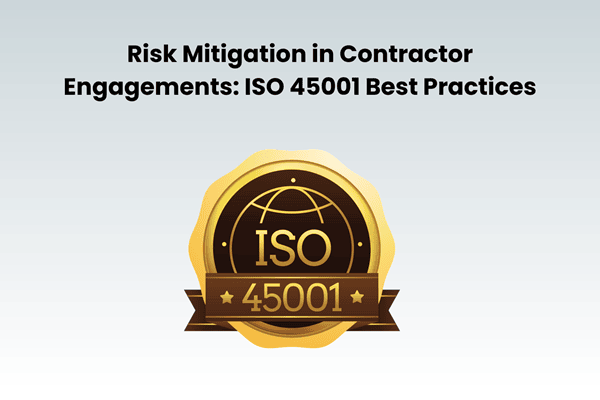Engaging contractors is a common practice across industries, but it comes with inherent risks. Ensuring the safety and compliance of contractors is crucial for the success of any project. ISO 45001, the international standard for occupational health and safety management systems, provides a framework for organizations to manage risks effectively. In this blog, we will explore the best practices for risk mitigation in contractor engagements according to ISO 45001 standards. Additionally, we’ll discuss the importance of ISO 45001 Training and its role in effective ISO 45001 Contractor Management.
Contents
What is 45001 ISO?
The internationally recognised ISO 45001 standard lays out the specifications for an occupational health and safety management system. It attempts to provide businesses with a foundation for raising worker safety, lowering workplace hazards, and establishing better, safer working environments. Although ISO 45001 is intended to be used by all types of organisations, contractor management is one area where its principles are especially pertinent since contractor management involves external parties, which might increase risk.
Best Practices for Risk Mitigation in Contractor Engagements
Prescreening of Contractors: It is essential to carry out a comprehensive prequalification procedure before hiring any contractor. This entails evaluating the contractor’s performance in terms of health and safety, regulatory compliance, and prior performance. The significance of choosing contractors who exhibit a commitment to safety and possess the requisite skills to carry out the task safely is emphasised by ISO 45001.
Clear Communication of Expectations: Clear communication of health and safety expectations is crucial when working with contractors. This entails giving them pertinent project details, possible risks, and the company’s health and safety procedures. To ensure that everyone engaged is aware of their roles and responsibilities, ISO 45001 strongly emphasises the need for efficient communication.
Risk Management and Assessment: Organisations must identify and evaluate risks related to contractor operations by ISO 45001 standards. Comprehensive risk assessments must be carried out to identify possible hazards, estimate their severity and probability, and put controls in place to lessen risks. Contractors should be included in the risk assessment process by organisations to make sure they understand the risks and can help build efficient control measures.
Training and Competency Development: Providing adequate training and ensuring the competency of contractors is essential for effective risk mitigation. In order to guarantee that contractors have the abilities and information required to carry out their tasks securely, ISO 45001 strongly emphasises the need for organisations to provide contractors with pertinent training. This covers instruction in emergency response, danger detection, and pertinent health and safety protocols.
Monitoring and Performance Evaluation: After contractors are hired, it’s critical to keep an eye on their work and ensure they follow all safety and health regulations. Organisations are encouraged by ISO 45001 to set up monitoring procedures to keep tabs on contractor operations, spot any straying from predetermined standards, and take appropriate remedial action. Frequent performance reviews assist in guaranteeing that contractors uphold strict safety regulations throughout the life of the project.
The Role of ISO 45001 Training in Contractor Management
To provide businesses and their contractors with the information and abilities required to properly manage health and safety hazards, ISO 45001 training is essential. People who take ISO 45001 training become more knowledgeable about the standards, guidelines, and recommended practices of the standard. As a result, they can guarantee adherence to health and safety laws and help create a safer workplace.
Topics like risk assessment, hazard identification, emergency preparation, and regulatory obligations are covered in ISO 45001 training for contractor management. By participating in this workshop, contractors may learn how to incorporate best practices into their work processes and increase their understanding of occupational health and safety problems. This helps everyone participating in the project work in a safer atmosphere, in addition to the contractors themselves.
Also read: How to Use AV Technology to Reach Your Business Goals?
Conclusion
Successful risk reduction in contractor engagements is essential to guaranteeing project success and safety. Organisations may reduce risks, enhance safety performance, foster a culture of health and safety excellence by adhering to the best practices listed in ISO 45001 and offering contractors pertinent training. ISO 45001 training is essential to this process because it provides people with the information and abilities they need to put best practices into practice and make the workplace safer for all.




